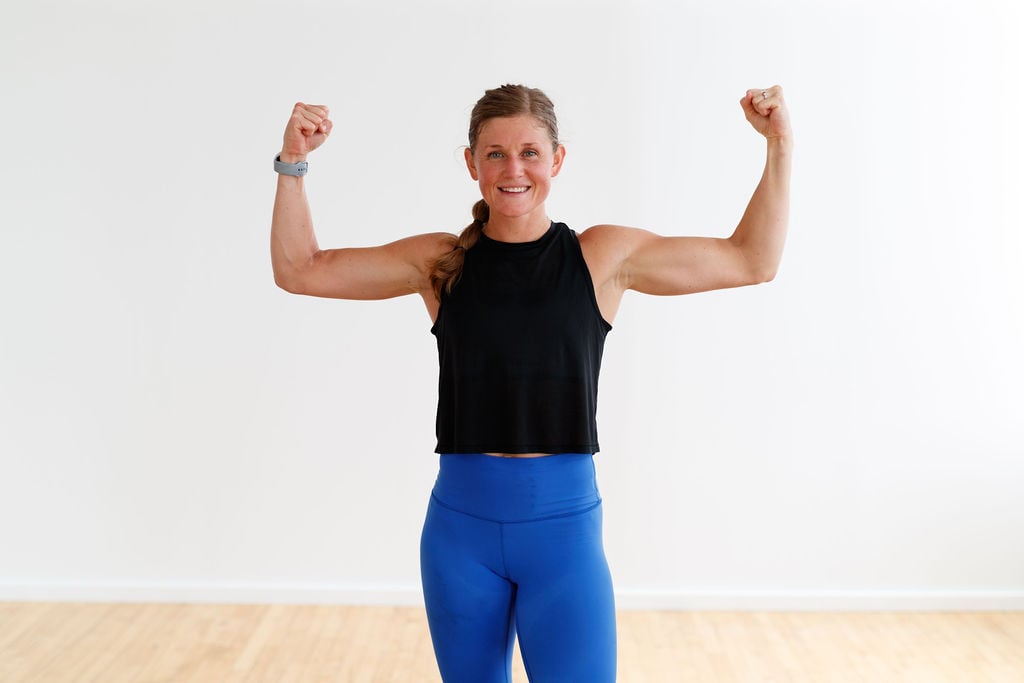The seven best strength exercises for a total body dumbbell workout. Target the lower body, upper body, abs and core using a set of weights. This full body strength workout is designed to build muscle and burn body fat in 35 minutes at home.
When I program a total body workout, I always include different types of movement:
Upper body push AND pull exercises; like a dumbbell chest press and a dumbbell back row.
Lower body push AND pull exercises; like a split lunge and a deadlift.
Multi-planar exercises, moving the body across multiple planes of motion, like lateral squats.
A combination of compound exercises for total body ensures all muscle groups are repeatedly being engaged, which is important if your goal is muscle growth.
This “formula” also includes exercises that mimic real-life movements. This is crucial for any type of full body workout as these functional training exercises can help improve balance, stability, performance, and reduce the risk of injury.
Today’s muscle-building workout combines seven compound exercises for total body into one quick and effective, 35-minute workout.
I’ve also structured this workout into one of my personal favorite formats: strict sets (repeating an exercise back-to-back before moving on to a new exercise). I find that this format encourages progressive overload, or increasing weights over time.
MEMBER SPOTLIGHT
MEET KARIE!
For more exclusive workout challenges, live workouts, nutrition chats, and direct support from our team, become a YouTube Member today.
Join Team NML
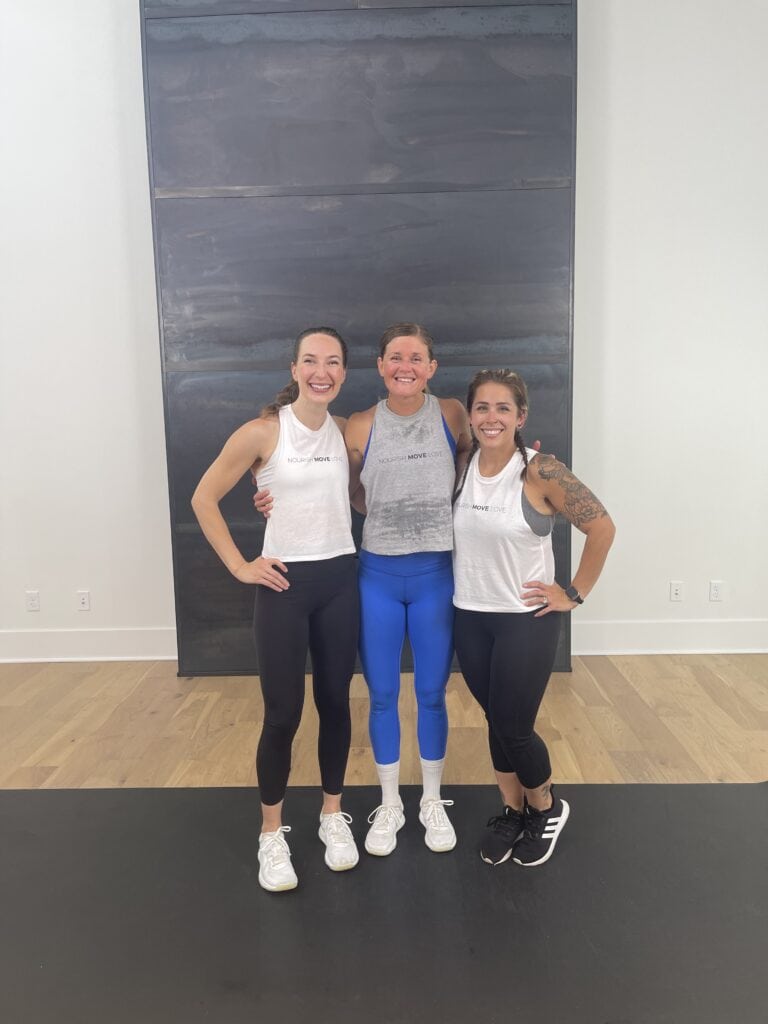
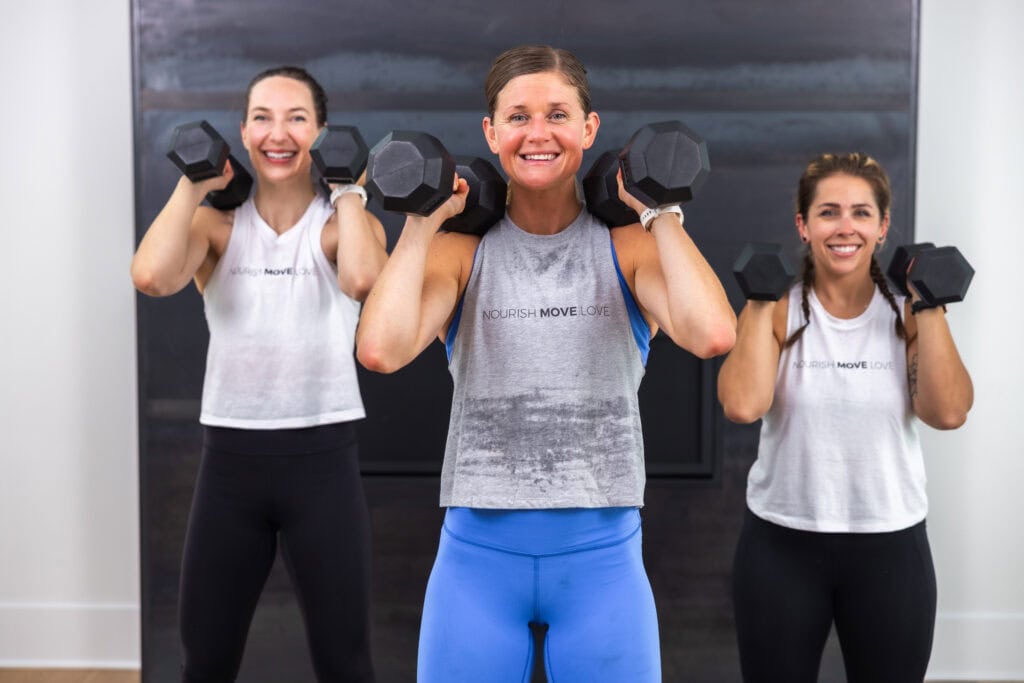
7 Exercises For Total Body
The best dumbbell exercises for total body strength.
A complete total body workout for women. Targeting every muscle group in the body: the lower body (quads, hamstrings, glutes, calves, and thighs), upper body (biceps, triceps, back, shoulders, and chest) and core.
Add full body strength training workouts like this one to your home workout plan one to two times a week to improve cardiovascular health, increase endurance and build strength.
Workout Instructions:
Follow along with the guided Total Body Workout Routine on YouTube, led by certified personal trainer, Lindsey Bomgren.
Your Workout Looks Like This:
7 Total Body Strength Exercises
Timed Intervals (30 seconds work, 15 seconds rest)
Strict Sets (repeat each exercise x2 sets, back-to-back)
Ab Burnout to end the workout
Workout Equipment:
Medium Pair of Dumbbells. I recommend between 5-25 lbs depending on your fitness level. We used 15 and 20 lb dumbbells in today’s workout.
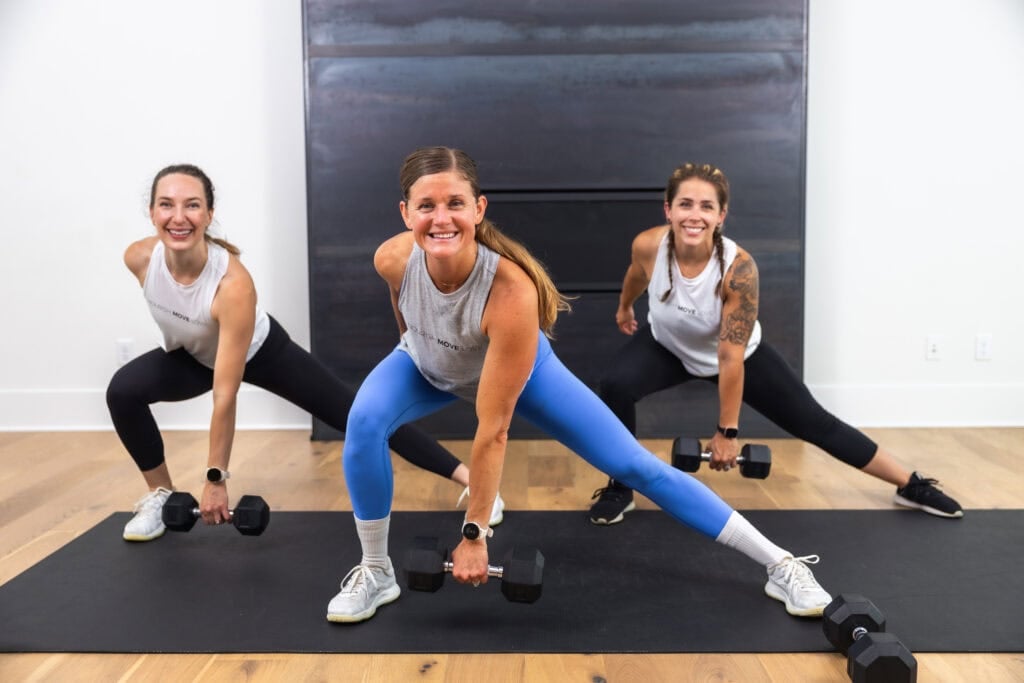
Workout Outline
2 Front Squats and 2 Push Presses
Staggered Deadlift and Bicep Curl
Curtsy Lunge to Standard Lunge
Lateral Lunge and Upright Row
Push Up and Back Row
Single Leg Glute Bridge Hold and Skull Crusher
4 Scissor Kicks and 4-Second Hamstring Bridge Hold
7 Best Exercises For Total Body
Front Squat and Push Press
Targets: Legs, glutes, quadriceps, hamstrings, hip flexors, adductors (inner thighs), shoulders and core muscles.
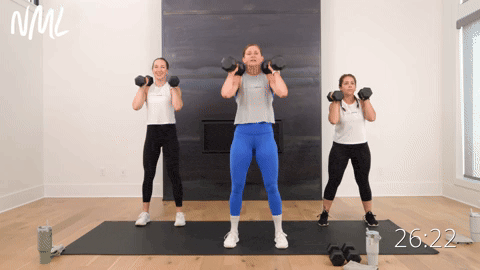
How To Do A Front Squat and Push Press
Stand with your feet shoulder-width apart or slightly wider. Hold a dumbbell in each hand at shoulder height (front racked position).
Inhale as you bend your knees and sit your hips back into a squat position (as if sitting down in a chair). Aim for 90 degree bends at each knee, focusing on pushing your knees out (not letting them cave in). Keep your torso in an upright position.
Exhale as you press through your heels to stand tall, driving your hips forward to return to standing position. Hold the dumbbells at your shoulders throughout the movement. Repeat to perform a second dumbbell front squat.
Press through your heels to stand tall after the second squat. Then, push the dumbbells overhead until arms are fully extended, biceps by ears. This is a dumbbell shoulder press.
Slowly and with control, lower the dumbbells back to your shoulders, then repeat for a second push press.
Staggered Deadlift and Bicep Curl
Targets: Hamstrings, glutes, core, lower back, and biceps.
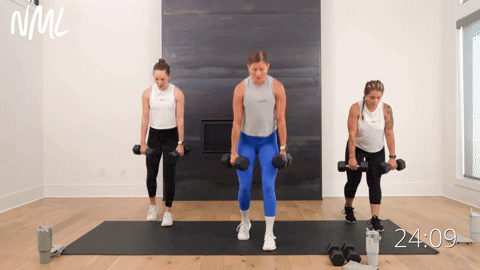
How To Do A Staggered Deadlift and Bicep Curl
Stand with feet hip-width apart, holding a pair of dumbbells (palms facing in towards your body).
Stagger your feet, so your right leg is slightly in front of your left foot. Kickstand your back left foot, left heel floating off the ground. Keep 80% of your weight in your front foot, 20% in your back toe.
Maintain a staggered stance as you hinge at the hips. Pushing your hips back towards the wall behind you as you glide the dumbbells down the front of your leg, keeping your core tight. Range of motion will look different for everyone.
Drive through your front right heel to push your hips forward, pulling the dumbbells back up towards your hips as you stand tall.
At the top of the deadlift, perform a bicep curl, curling the dumbbells up from your hips to shoulder height. With control, lower the dumbbells back down to your hips.
Curtsy Lunge to Standard Lunge
Targets: Legs, quads (thighs) and gluteus maximus (butt), hip flexors and core.
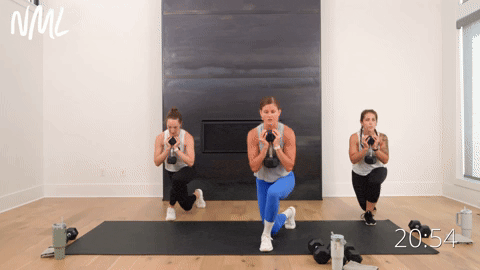
How To Do A Curtsy Lunge to Standard Lunge
Stand with feet hip-distance apart, holding one dumbbell vertically at your chest (goblet hold).
Step your left leg back into a curtsy lunge (left knee should meet right calf), left knee lowers towards the mat. Lower your hips until both knees reach a 90-degree angle, front thigh parallel to the floor.
Then squeeze your right glute as though you were going to stand tall, but rather than coming up to standing, step the left leg back into a standard reverse lunge position. Again, lowering your hips until both knees reach a 90-degree angle, front thigh parallel to the ground.
Squeeze your right glute as you step your left leg back into a curtsy lunge position to repeat the sequence. Keep constant tension on the right leg and glute throughout the entire movement, never standing tall as you switch from curtsy lunge to staggered lunge.
Lateral Lunge and Upright Row
Targets: Gluteus medius (the outer part of your butt used for side-to-side movements), quads, hamstrings, hip adductors and abductors, hip flexors, calves, core and shoulder muscles.
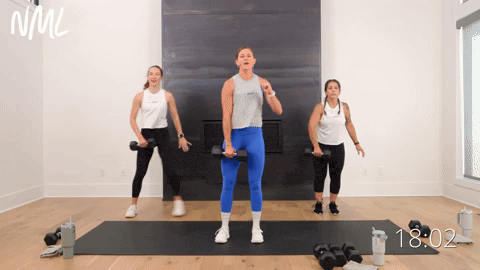
How To Do A Lateral Lunge and Upright Row
Stand with your feet under hips, holding a dumbbell in your left hand.
Step your right leg out to the side as you push your hips back, bending your right knee while leaving your left leg straight. Think of performing a single leg squat with your right leg while your left leg remains straight. Knees and toes are pointing forward.
Then, drive off your right foot to reverse the movement, stepping back to center.
As you stand tall, pull your left elbow up towards your left shoulder, gliding the dumbbell up your body. This is an upright row.
Push Up and Back Row
Targets: Arms, chest, shoulders, triceps, back, core and abs.
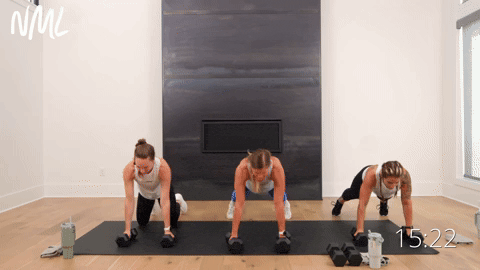
How To Do A Push Up and Alternating Back Row
Start in a high plank position, straight line through your torso. Place your hands on a pair of dumbbells.
Lower your chest towards the mat to perform a push up; elbows fall back towards your hips.
Push back up into a high plank position, then perform a back row on your right arm. Pull your right elbow up to meet your rib cage. Squeeze the shoulder blade to lift the dumbbell off the mat. Hips stay square to the mat in high plank.
With control, lower the dumbbell back to the mat and perform another push up.
This time, at the top of the push up, alternate the back row by performing a back row on your left arm.
Modification: Option to drop to your knees, performing the push up and row from your knees. You can also take this exercise to an incline by placing your hands on a chair or bench.
Single Leg Glute Bridge Hold and Skull Crusher
Targets: Legs, glutes, hamstrings, inner thighs, triceps (back of the arm) and core.
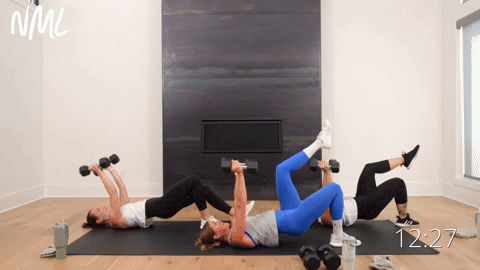
How To Do A Single Leg Glute Bridge Hold and Skull Crusher
Start laying on your back, right foot planted flat on the ground, left foot extended straight overhead (ankle stacked over knee). Hold one dumbbell in each hand, fully extending your arms so the dumbbells are directly overhead, palms facing one another.
Press through your heel to lift your glutes off the mat, squeezing your glutes as you lift. Think about keeping your core engaged and knees in line with your hips. Hold this single leg glute bridge.
Bend at the elbows to slowly lower the dumbbells towards your head (just bending at the elbows). This is a skull crusher.
Then push the dumbbells back overhead to return to the starting position. Repeat to perform as many skull crushers as possible in the timed interval, maintaining the single leg glute bridge hold the entire time.
Modification: Option to perform skull crushers while holding a staggered or double leg glute bridge (keeping both feet on the ground).
Scissor Kick and Hamstring Bridge Hold
Targets: Rectus abdominis, transverse abs, lower abs, glutes (gluteus medius) and hamstrings.
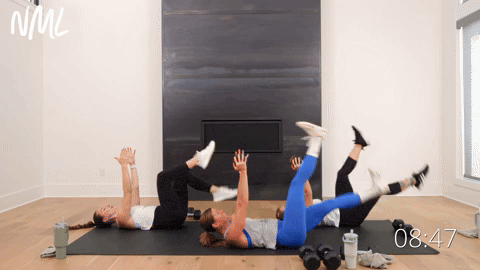
How To Do Scissor Kicks and Hamstring Bridge Hold
Start lying on your back. Press your low back firmly into the mat and think about “wrapping” your abdominal wall around your core. Hold one dumbbell horizontally directly overhead.
Straighten your legs and extend them over your hips, the bottom of your feet facing the ceiling.
Slowly lower your right leg towards the ground, keeping both legs as straight as possible. Hover your leg a few inches off the floor. Focus on keeping your lower back pressed into the mat.
Reverse the movement, lowering your left leg towards the ground while raising your right leg to extend overhead. Repeat to perform four alternating scissor kicks.
After the fourth scissor kick, place both heels on the mat and drive into the heels as you lift your hips off the ground. The movement is similar to a glute bridge, but because your feet are further from your glutes, the emphasis is placed on the hamstrings.
Hold the hamstring bridge for a 4-count. Then, drop the hips to the ground and repeat four scissor kicks.
Modification: Shorten the range of motion for the scissor kicks by keeping the knees bent and alternate tapping opposite toes to the mat. Omit the hamstring bridge and bring the knees closer to the butt, performing a standard glute bridge hold. You can also omit the overhead dumbbell hold, performing this exercise with just your body weight.
Exercises For Total Body FAQs
Compound exercises work multiple muscle groups at one time to perform a lift or movement. For example, a squat engages the muscles in your glutes, quads, hamstrings, calves and core. A push up engages the chest, shoulders, triceps, back and core. Some of the best examples of compound movements include squats, push ups, pull ups and burpees.
Pin This Workout: 7 Exercises For Total Body
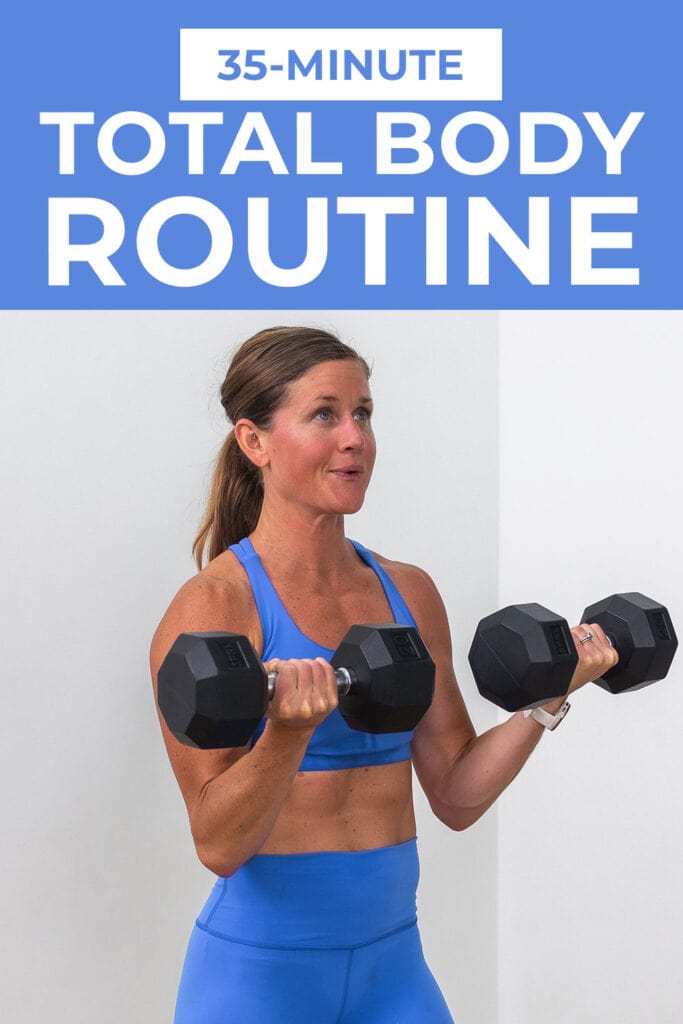
This post includes affiliate links. I do earn a commission for products purchased using these links (at no additional cost to you). Thank you for supporting Nourish Move Love, making the content you see on this blog possible.

